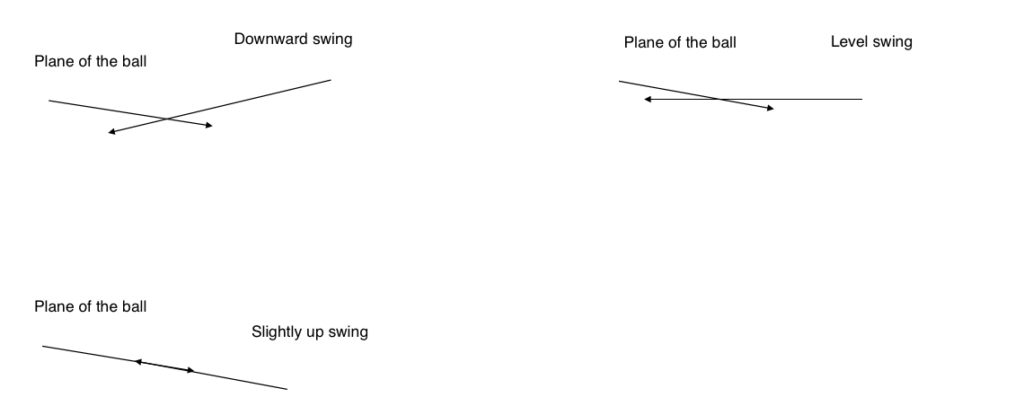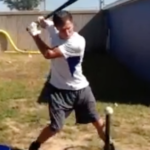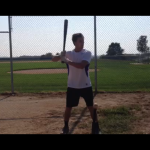Two Hitting Myths
Over and over again during the 2014 world series Tom Verducci and Harold Reynolds extolled the virtue of hitters staying level through the hitting zone and just trying to put the ball in play. These phrases pander to the average MLB fan, sound very practical, and romanticize the thought that any old Joe can play Major League Baseball if they can just put the ball in play and hit singles.
The Level Swing Myth
Travel to any little league, travel ball, or high school game in the country, and you are likely to hear someone on the field or in the stands tell the hitter to “swing level.” While this sounds great and logical because level swings should produce line drives, it is actually misguided.
Hitting is about timing, and if your timing is just slightly off, there had better be some margin for error. Hitters with a down swing, or level swing, have very little margin for error. They must be exactly on time to make contact.
The ball is coming slightly down to the hitter (the rising fastball is another myth of the game) and if the plane of the bat doesn’t match that of the ball, the chances of the hitting making contact and doing damage are greatly reduced.
Get our 5 top hitting drills that translate practice skills to game performance
The announcers and production staff of the 2014 World Series so far as to draw a straight line on the screen overlaying a Hunter Pence swing. As clear as day on the screen was Hunter Pence dropping his barrel below the line, matching the plane of ball, the barrel crossing the line as it came up, and him crushing a double into left center. Clearly a slightly up swing path.
Check out our 5 hitting drills that translate practice skill to in-game performance.
In fact, the ball is coming about 8-13 degrees down, so ideally, the bat would be moving about 8-13 degrees up through the hitting zone to maximize the margin of error for the timing.
Additionally, swinging down and hitting the top of the ball produces many ground balls. While lazy fly balls drive hitting coaches crazy, pitching coaches know that balls on the ground can’t do very much damage. Why would pitching coaches tell their pitchers to get the ball on the ground if that was how runs were created?
A slight upward swing on the ball increases the chances for “deep line drives” that often produce extra base hits.
No matter how hard people want to romance the level swing, quality major league hitters simply don’t do it. It doesn’t pass the eye test.
The put the ball in play myth
I will admit, there is something to putting a ball in play and making young defenders make plays. At the high school level, good fielding teams will field about .930, which means they will make about 7 errors for every 100 chances.
However, as you climb the baseball ladder (and even from a young age, that should be the goal right?) relying on defenders to put you on base becomes a less and less profitable proposition.
The fact of the matter is, players must be able to do damage with their swings in order to move up the ladder. There are a number of other ways to contribute to a team, but being able to do damage with the bat might be the one that gets you in the lineup, gets you noticed, and allows you to play at the next level.
In fact, telling a young player to “just put the ball in play” with less than two strikes might be one of the most damaging things you can tell a young player. It saps the aggressiveness and intent out of their swing.
Success becomes simply hitting the ball, not hitting the ball with authority. This leads to a number of problems with the swing and approach. Hitters tend to get very “handsy” with the swing taking most lower body actions out of the swing.
They also tend to swing at strikes that are not good pitches to hit early in the count. Because they get praised for just putting the ball in play, not hitting the ball hard, making soft contact on a pitch on the edge of, or outside of the strike zone, is seen as a successful at bat.
Obviously an adjustment needs to be made with two strikes, but telling hitters to just put the ball will put a glass ceiling on their development. If this passive philosophy is developed early in a playing career, it will be almost impossible to reverse as the player gets older.
On the other hand, if the intent to do damage with every swing is present, hitters can be taught proper movement patterns, and their approach will be more conducive to creating quality at bats.
Conclusion
Hitting coaches that reject these myths have a greater chance of producing hitters who make more contact, do more damage, and ultimately are able to move up the baseball ladder.
Bonus
Check out our 5 hitting drills that translate practice skill to in game performance.
Cornerstone's Free Bronze Membership - Totally free membership area includes all podcast and blog premium documents, ebooks, drill videos, and much, much more.
Cornerstone's Elite Membership - Weekly batting practice plan, 10 practice plan series that covers every aspect of the game, over 60 tactical games to promote competitiveness in practices, and so much more!
 Posted by Kyle Nelson
Posted by Kyle Nelson- Posted in Hitting
 Feb, 01, 2017
Feb, 01, 2017 No Comments.
No Comments.
Elite members login here
Check out what’s New/Hot!
Recognizing, Diagnosing, and Fixing Common Hitting Flaws eCourse The 3 metrics we tested on Blast motion sensors this year Sneak Peek Inside an Elite Q and A The batting practice continuum Elite Member’s area table of contents 50+ “Chaos” hitting drills
5 sample Chaos hitting drills FREE
Mental Skills and Culture Building The hitting pyramid Welcome Elite Member, Trey! Ideas for a pitcher first practice 12 week bat speed improvement plan Make plans this offseason to have your team playing their best baseball at the end of the year” Top 5 hitting drills to translate practice skill to game performanceHow we used Blast Motion sensors with a team in 2019
What to do if your hitters are overmatched Welcome Elite Member, Tommy! Setting your baserunners up for success Welcome Elite Member, Mike! A consulting call with Elite Member Matt FREE Web Clinic: Developing Athletic, Consistent, Extraordinary Infielders
 Coach Kyle Nelson
Coach Kyle Nelson





